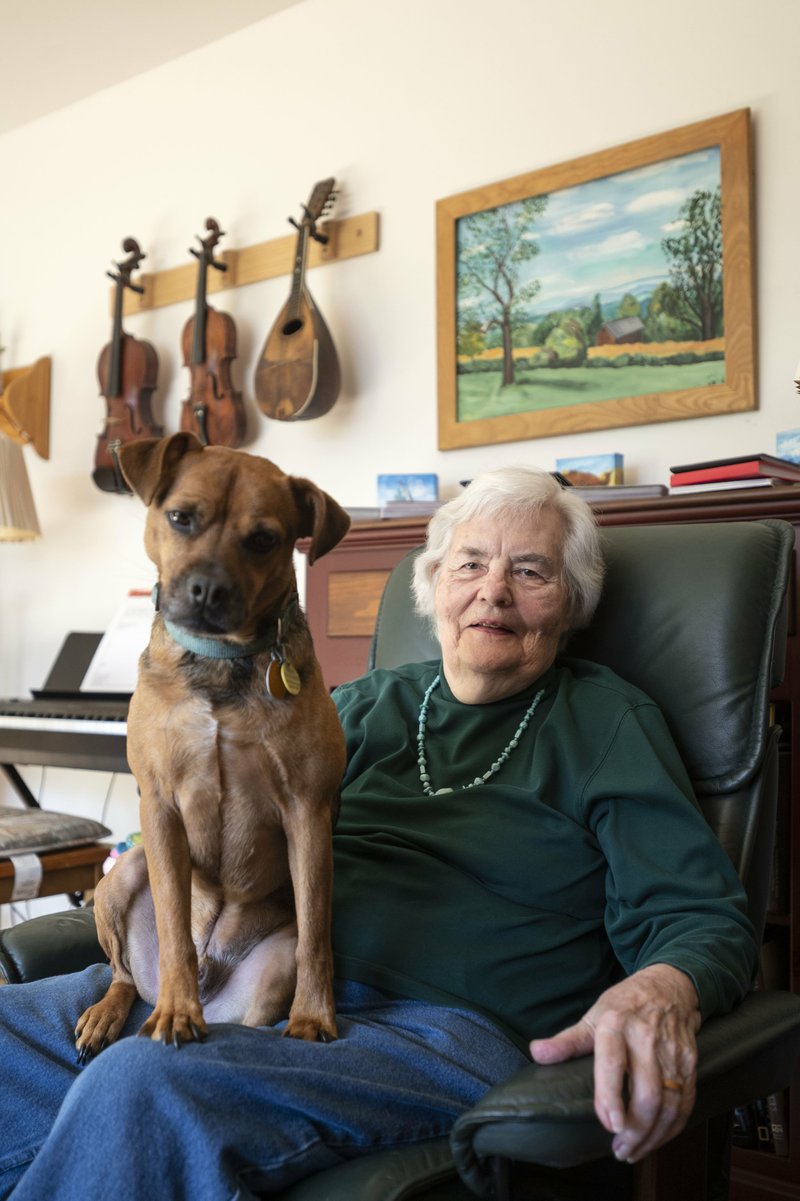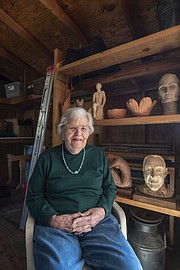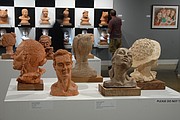Norma Tomboulian will be 89 years old next month. The Michigan native -- whose exhibit, "Life Into Clay," is running at the Fort Smith Regional Art Museum through Jan. 5 -- spent much of that life raising four children, helping her husband run his business and working in various careers. But one thing never changed over the years: She always saw herself as an artist, and the creative energy she had experienced since she was a toddler never stopped inspiring her.
"When I was 3, maybe, my folks got me a blackboard on an easel, and then, the next summer, I can remember squatting next to a mud puddle, trying to make animals out of the mud," says the artist, sitting in the living room of her Springdale home. Her adorable rescue pup, Joe, rarely leaves her lap during an hour-long conversation. Musical instruments and impressive artwork created by her children line the walls; it's clear they inherited their mother's artistic talents.
Through Others’ Eyes
Norma Tomboulian
“Dad didn’t consider himself artistic, but when you look at the things he did — designing all kinds of buildings, and how all of the stuff would go together — that was an amazing and artistic effort, from my point of view. And so much of it had to work beautifully without being seen. They were both supportive of all of us — we all got into art and music in different ways, and went in different directions as adults.
“They were married for 52 years, from the time they were 20 until he died. They worked together, ran a business together, and supported each other. They sang in choirs together, they were volunteer EMTs together … they did it for almost 20 years until their 50s, when it got too difficult to lift people.
“He was so supportive of her. If she wanted to go out and spend money on art materials and the budget was tight, it was, ‘Go for it.’ Not that she was ever extravagant, but sometimes you’ve got to do what you’ve got to do. One time, she donated a painting to the church rummage sale. Dad went to the rummage sale and bought it and brought it back home and said, ‘Now this is staying here, right?’” — Eden Miller
“This was later in life, but I can very well remember when [Mom] had pieces going to shows, Dad used to build the most beautiful crates you’ve ever seen — they were works of art, in my opinion. He loved the fact that she was doing it, and was excited about the fact that the pieces were going out to shows.” — Necia Parker-Gibson
“All of her sculptures are hollow on the inside, but she doesn’t start with a huge block of clay and then carve it out. She hollows it out first, and then the face of the person begins to form. That’s not the most unique technique in the world, but it’s one of the most difficult techniques. It takes an artist with a lot of skill and control.
“I think it’s fun to see how her clay and watercolor works interact. I think the watercolor gives her the opportunity to work with color, while, in general, clay is monochromatic. She is a really diverse artist.” — Samantha Rhodes
Next Week
Ross DeVol
Bentonville
"Mom has been making art as long as I can remember," says eldest daughter Eden Miller. "As a little girl, it just seemed natural that a woman might cook, clean, shop, sew and paint -- all in the same day. It was fascinating to see paintings or silverwork or sculpture come alive under her hands; and, of course, it inspired me to want to go and do likewise."
"I know we always had art supplies -- it wasn't a case where you had to save up to buy your next box of crayons," says daughter Necia Parker-Gibson, who adds that she remembers growing up "watching [my mother] do art, and also being encouraged to work on a project on my own at the same time."
After her birth in Michigan, Tomboulian and her family -- which included two younger brothers -- relocated to Ithaca, N.Y., for her father's new job working in the Extension Department at Cornell University. Her parents were supportive of her developing artistic talents, and when Tomboulian's mother realized that Cornell was the home to noted American artist Kenneth Washburn, she asked him for help.
"My mother talked to him and asked if I should have drawing lessons," she remembers. "She told him I was drawing all of the time. And he said, 'No, just give her all the drawing supplies she wants and get out of her way.' And when I was about 13 or 14, he was teaching a night school class in Ithaca. My mother took me down there, and he had to say, 'Look, I'm sorry, but this class is for adults, and you're not even 16 yet.'"
Tomboulian's mother was not to be deterred.
"She talked to the Methodist minister in town who had done some painting and arranged for him to come to the high school and give lessons in painting," she says. "And three of us took them, three young women. So that was interesting. I got one of those paintings into the first art show I have ever entered. The judge said that the composition was atrocious, but the little horse was so alive that she couldn't leave it without an award."
Tomboulian was also academically gifted, and, at the end of high school, she was awarded scholarships that were sufficient enough to pay for tuition at the prestigious Cornell. That her parents were supportive of her seeking a higher education was an anomaly: This was the mid- to late-1940s, a time when less than 5% of women had a college degree. But higher education was highly prized in Tomboulian's extended family.
"I rode to campus with the campus mailman and his wife," says Tomboulian. "They were in the front two seats, and I went in the back of the mail van, sitting on a piece of plywood. I rode home on a Greyhound bus, which came through campus. It cost me a quarter every day."
Though her parents supported her quest for a college degree, they begged her not to major in art because they feared it wasn't practical. Her father, in particular, advised her in a completely different direction.
"He said, 'You need to go to a secretarial school because then you'll always be able to get a job,'" she says. So she tried to go a more practical route: She liked animals, so started out majoring in biology before moving to zoology.
"But when it became time for me, the next term, to dissect a human cadaver, I said, 'This is enough.' And I said, 'OK, I'm majoring in art.'"
Man of her dreams
Her junior year, Tomboulian met a young man named Clyde.
"He was a Cornell professor's kid, and we would walk together or go to lunch," she says. "We were in an art history class our junior year and were in the Museum of Casts studying the sculptures, and he was telling me all about how terribly he's getting along with my roommate with whom he's fallen in love. And I knew she was in love with somebody else. Finally, I said, 'Why don't you take me out sometime?' He said, 'I thought you were going steady?' and I said, 'I was.' So he said, 'How about dinner and a movie?' That was the 13th of January, and we eloped during spring break and got married on March 27. Neither of our parents thought that was a good idea. As far as his parents knew, Clyde had only had two dates, which they had arranged with visiting professors' daughters. And as far as my father was concerned, the Prince of Wales wouldn't have been good enough for me."
Despite their parents' initial misgivings, the match was an excellent one -- or, as Tomboulian put it, she and Clyde were "welded together" -- and their marriage would ultimately span 52 years, until Clyde lost his battle with cancer. For their first several decades together, the couple stayed in upstate and central New York, while Clyde built his business as a master electrician, plumber and, later, an HVAC technician.
"He had a business for most of that time, and I was the one who answered the phone and got the bills out and paid the bills and chased the money and did all those things," she says. "Sometimes it was just Clyde, sometimes there were employees, but I was always involved with the business."
The support was mutual: When the kiln at the art center where Tomboulian created her sculptures ruined a huge piece of art by running too hot, Clyde found a kiln for her and had it moved to their house.
"One day, I remember I woke him up," she says. Inspiration had struck, and it couldn't wait. "I said, 'Clyde, please, I need two saw horses, a sheet of three-quarter plywood, and two 50-pound cans of clay. Now.' He said, 'Oh, OK.' And, even before his coffee, he went and put on his shoes, and he helped set up the table for me."
Miller confirms that her childhood was one surrounded by artistic pursuits of every stripe.
"She and Dad encouraged [our creativity] all along the way," she says. "There were always a lot of books and music. I was the oldest kid by four years, and I had a record player from so far back I don't even remember learning to use it.
"One Christmas, when the money was tight, she did what she could to make it a little more festive -- we didn't have a fireplace, but she made one. She took some paper and crayons and drew a fireplace and a crackling fire."
Listening to Tomboulian reminisce, it's very clear that Clyde and Tomboulian not only loved each other, but also liked each other and being in one another's company. Clyde talked her into joining the church choir; he was proud of his voice, but she had always thought she couldn't sing.
"I'd been convinced that I couldn't sing when I was in chorus in high school," she says. "But, by gum, I discovered I could perfectly well sing alto."
When Clyde, who had been a volunteer fireman, had to quit that job for health reasons, he moved on to a volunteer emergency medical team and suggested Tomboulian join him. It was a service they continued when they moved down south to Arkansas. Her parents were living in Lincoln, and, during one visit, the contrast of the warm spring weather with the frigid central New York winter was pronounced.
"It was March, and, of course, the daffodils were coming out, violets were blooming and here we were, running around in flannel shirt sleeves," she says. "And Clyde called, and I said, 'How's the weather?' He said, 'It's 10 below and snowing horizontally out of the northeast.' That was a particularly bad winter. Pipes froze six feet down, and the picnic table in the backyard disappeared underneath the snow. I had a three-wire electric fence in the yard to keep my horses in, and the snow covered that up and became so hard that, one day, they just walked out over the top. That was a horrible winter. And when I got home, I said, 'I think we should move to Arkansas.' He said, 'What's the matter with you? I don't even know you! You're crazy!'"
But she couldn't let go of the idea. That fall, as she faced the prospect of another brutal winter on the horizon, she arranged for Clyde to visit her parents on a long weekend.
"It was the first Lincoln Apple Festival that weekend," she says. "And he came home and said, 'How do you want to do this?'"
Artist in Arkansas
By 1977, the couple had settled their family in Lincoln.
As her children grew up and left the house, several of them attending the University of Arkansas, Tomboulian would have more freedom to devote to her art -- not that she ever let motherhood stop her from creating.
"I was always either painting or making sculptures in the kitchen," says Tomboulian. "My cleaning woman was very patient. She cleaned up the mud. I also made my own bread, and the kids were perfectly used to having Mom make art as well as bread, cooking and so on in the kitchen."
She continued to take classes, always working a little bit more creatively than the other students: She knew how to distinguish herself from a crowd.
"We had a model who was a man, a flamenco dancer," she remembers. "He wasn't a very big guy, but he was sitting there, posing, and he was bored to death. And I thought, 'He looks like nothing so much as a rooster.' So I turned him into a rooster. I gave him a comb and a beak and feathers along the back of his arms and wings.
"That was so fun."
Tomboulian's focus narrowed to painting and sculpting early on in her artistic career.
"She works primarily in clay and watercolor, and both of those mediums are considered a little bit challenging, and you wonder: why would she be interested in both?" says Fort Smith Regional Art Museum Assistant Curator Samantha Rhodes. "Usually, artists may dabble in different types of media, but they tend to choose one over the other. That's not the case with Norma. She's skilled in both. With clay, she has a lot of control, and she can make really intriguing pieces, while, with watercolor, it's mercurial -- you can't really take back what you do, because it dries almost immediately. So one provides her with a lot of control, and the other requires a lot of patience -- and that's why, I think, she likes to switch between the two. She's a diverse artist in her own right."
Though she's skilled in both, Tomboulian says sculpture was the medium that inspired the most passion in her.
"When I was working with a sculpture, I was absolutely concentrated into it," she says. "I can't call it a trance, because I certainly knew what I was doing, but I was just absolutely concentrated in a way that I've never been with anything else. And I would come out, after working hours, exhausted, and then go into working on something else and come back to it later."
When she was inspired by something, she worked out the inspiration in clay: In the mid-1990s, a fascination with Razorback basketball manifested itself in a startlingly realistic bust of then-Razorback coach Nolan Richardson. A fan of the Diana Gabaldon "Outlander" series of books, she created busts of the main characters, Jamie and Claire Fraser. Once these art pieces were completed, she didn't keep them for herself -- instead, they were presented to those who had inspired the creation to begin with, Richardson and Gabaldon. This generosity of spirit is demonstrated in the gifts Tomboulian has made to the Fort Smith Regional Art Museum over the years, including a chess set comprising life-sized sculpted heads titled "The Camelot Chess Set."
"I've given them several things beside the chess set, and I've been assured that, anything my kids don't take, they will be happy to take on loan," she says.
The exhibit now at Fort Smith Regional Art Museum is a true retrospective of Tomboulian's life in art. She says it includes sculpture pieces she created while she was at Cornell and a painting completed just last year. It's a rare chance to see the entire scope of an artist's life, as it evolved over time. But it's far from the last chance to see Tomboulian's art at FSRAM -- in addition to the pieces she's donated thus far, she plans on making more donations eventually. She sees it as a way to make sure her art speaks to future generations. Her daughter, Parker-Gibson, has also made donations of her mother's work to the museum for the same reason, as when she donated a sculpture her mother created of a couple who were close family friends: their former choir director and his wife, both of whom are people of color. Parker-Gibson says the donation was made "in the interest of the representation of people of color."
"I know there have to be school kids who are people of color coming to the museum, and it's always important to have someone around who looks like you," she notes.
That her work will live on to inspire future generations is a comforting thought to Tomboulian.
"The [FSRAM] director said to me, 'Think of all of the kids' classes that will be coming through here," she says. "They'll all see your work. Think of it not as giving them away but as giving them to the future.'"
NAN Profiles on 11/24/2019



